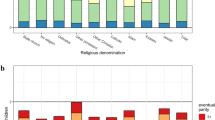Abstract
College-educated Catholic women in the 1976 National Survey of Family Growth had higher actual and expected fertility than did college educated Protestants. Moreover, Catholic colleges or universities had a pronatalist effect on alumnae. Thus, a significant part of the higher Catholic than Protestant cumulative fertility among college-educated women arose from the greater propensity of such Catholics to attend sectarian schools and colleges. The implications are explored.
Similar content being viewed by others
References
Bouvier, Leon F., and S.L.N. Rao. 1975. Socioreligious Factors in Fertility Decline. Cambridge: Ballinger Publishing Company.
Freedman, Ronald, Pascal K. Whelpton, and John W. Smit. 1961. Socio-Economic Factors in Religious Differentials in Fertility. American Sociological Review 26(August):608–614.
Grady, William R. 1979. National Survey of Family Growth Cycle II: Sample Design, Estimation Procedures, and Variance Estimation. Bethesda: National Center for Health Statistics.
Greeley, Andrew M. 1967. The Changing Catholic College. Chicago: Aldine Publishing Company.
— 1969. From Backwater to Mainstream. New York: McGraw-Hili.
— 1977. The American Catholic: A Social Portrait. New York: Basic Books.
Greeley, Andrew M., William C. McCready, and Kathleen McCourt. 1976. Catholic Schools in a Declining Church. Kansas City: Sheed & Ward, Inc.
Herberg, Will. 1960. Protestant, Catholic, Jew. Garden City, New York: Doubleday Anchor Books.
Janssen, Susan G., and Robert M. Hauser. 1981. Religion, Socialization, and Fertility. Demography 18 (4):511–528.
Johnson, Nan E., and C. Shannon Stokes. 1976. Family Size in Successive Generations: The Effects of Birth Order, Intergenerational Change in Lifestyle, and Familial Satisfaction. Demography 13 (2):175–188.
Kmenta, Jan. 1971. Elements of Econometrics. New York: Macmillan Publishing Company.
Lenski, Gerhard. 1961. The Religious Factor. New York: Doubleday.
Marcum, John P. 1981. Explaining Fertility Differences Among U.S. Protestants. Social Forces 60 (2):532–543.
Marini, Margaret Mooney, and Peter J. Hodsdon. 1981. Effects of the Timing of Marriage and First Birth on the Spacing of Subsequent Births. Demography 18 (4):529–548.
Ryder, Norman B., and Charles F. Westoff. 1971. Reproduction in the United States, 1965. Princeton: Princeton University Press.
Westoff, Charles F. 1975. The Yield of the Imperfect. Demography 12 (4):573–580.
Westoff, Charles F., and Elise F. Jones. 1977. The Secularization of U.S. Catholic Birth Control Practices. Family Planning Perspectives 9 (5):203–207.
—. 1979. The End of “Catholic” Fertility. Demography 16 (2):209–217.
Westoff, Charles F., Robert G. Potter, Jr., Philip C. Sagi. 1963. The Third Child. Princeton: Princeton University Press.
Westoff, Charles F., Robert G. Potter, Jr., Philip C. Sagi, and Elliot G. Mishler. 1961. Family Growth in Metropolitan America. Princeton: Princeton University Press.
Westoff, Charles F., and Raymond H. Potvin. 1967. College Women and Fertility Values. Princeton: Princeton University Press.
Westoff, Charles F., and Norman B. Ryder. 1977. The Contraceptive Revolution. Princeton: Princeton University Press.
Williams, Dennis A. 1981. Why Public Schools Fail. Newsweek (20 April):62–65.
Zimmer, Basil G., and John Fulton. 1980. Size of Family, Life Chances, and Reproductive Behavior. Journal of Marriage and the Family 42 (3):657–670.
Author information
Authors and Affiliations
Rights and permissions
About this article
Cite this article
Johnson, N.E. Religious Differentials in Reproduction: the Effects of Sectarian Education. Demography 19, 495–509 (1982). https://doi.org/10.2307/2061015
Issue Date:
DOI: https://doi.org/10.2307/2061015




